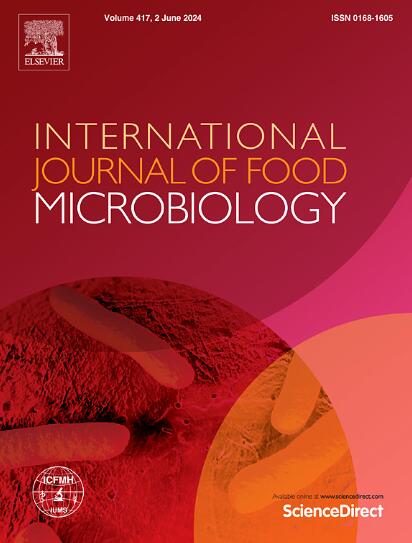从微生物组学的角度解读新疆冠壳鱼精蛋白对草鱼鱼片冷藏保存的保鲜作用
IF 5.2
1区 农林科学
Q1 FOOD SCIENCE & TECHNOLOGY
International journal of food microbiology
Pub Date : 2025-04-28
DOI:10.1016/j.ijfoodmicro.2025.111222
引用次数: 0
摘要
鱼精蛋白是一种天然阳离子肽,由于其对多种革兰氏阴性和阳性细菌的抗菌能力,已被用作食品防腐剂。尽管抗菌机制已经被很好地揭示,但它在复杂的食品微生物群落中的作用在很大程度上是难以捉摸的。本研究采用鱼精蛋白和以鱼精蛋白为基础的复合防腐剂处理草鱼鱼片,在4℃条件下保存15 d。采用16S rRNA扩增子测序法对冷藏期间的pH、总活菌数(TVC)和总挥发性碱氮(TVB-N)进行监测,并对细菌群落进行检测。鱼精蛋白,尤其是复合鱼精蛋白保鲜剂,能降低鱼片贮存过程中的pH值、TVC和TVB-N,延长鱼片的保质期。鱼精蛋白及其复合防腐剂对鱼片冷藏过程中细菌群落的影响与对照有显著差异。鱼精蛋白处理显著改变了常见的气单胞菌、假单胞菌和荚膜菌属。其中18个属与鱼精蛋白的抑菌活性密切相关。鱼精蛋白处理后的鱼片具有更复杂和稳定的细菌群落。本研究描述了鱼片冷藏过程中细菌群落的动态变化,并从微生物群的角度对鱼精蛋白的抗菌机制进行了深入的了解。本文章由计算机程序翻译,如有差异,请以英文原文为准。
Deciphering the preservative effects of protamine from Xinjiang Coregonus peled on grass carp (Ctenopharyngodon idellus) fillets during refrigerated storage: a perspective from the microbiome
Protamine is a natural cationic peptide which has been utilized as a food preservative, since its antibacterial capability against a wide range of Gram-negative and -positive bacteria. Despite the antibacterial mechanism has been well uncovered, its role in complex food microbial communities is largely elusive. In the present study, grass carp (Ctenopharyngodon idellus) fillets were treated with protamine and a protamine-based compound preservative, and stored at 4 °C for 15 days. The pH, total viable count (TVC), and total volatile base nitrogen (TVB-N) were monitored during the refrigerated storage, as well as the bacterial communities by 16S rRNA amplicon sequencing. Protamine, especially the protamine compound preservative, reduced the pH, TVC and TVB-N during the storage, and prolonged the shelf life of fish fillets. Bacterial communities on fillets during the refrigerated storage challenged by protamine and its compound preservative significantly differed from that in control. Prevalent genera including Aeromonas, Pseudomonas, and Myroides were significantly altered by protamine treatment. A group of 18 genera were closely associated with the antibacterial activity of protamine. The fillets treated with protamine possessed a more complex and stable bacterial community. Our study depicted a dynamic alteration of bacterial communities during the refrigerated storage of fish fillets, and offered an insight into the understanding of the antibacterial mechanisms of protamine from a microbiota perspective.
求助全文
通过发布文献求助,成功后即可免费获取论文全文。
去求助
来源期刊
CiteScore
10.40
自引率
5.60%
发文量
322
审稿时长
65 days
期刊介绍:
The International Journal of Food Microbiology publishes papers dealing with all aspects of food microbiology. Articles must present information that is novel, has high impact and interest, and is of high scientific quality. They should provide scientific or technological advancement in the specific field of interest of the journal and enhance its strong international reputation. Preliminary or confirmatory results as well as contributions not strictly related to food microbiology will not be considered for publication.

 求助内容:
求助内容: 应助结果提醒方式:
应助结果提醒方式:


